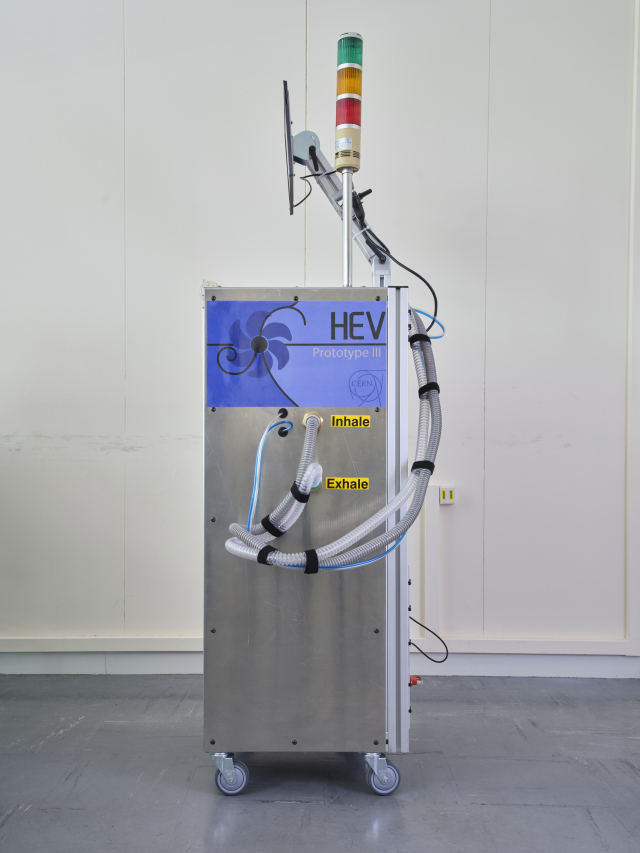HEV ventilator
CERN
Solution Overview & Benefits
Information updated: June 10th 2020
HEV is a general purpose ventilator designed to provide long term alveolar ventilation support to patients, both in and out of intensive care. The design is based on easily-sourced and inexpensive components, and the control software is encapsulated in a dedicated micro-controller which favours the deployment of HEV in areas with limited resources and unstable power distribution. The design is modular and adaptable to a wide range of needs and geographic deployment. HEV was designed to be easily be modified and repaired, with implementation depending on local requirements.
HEV targets pressure controlled modes: PC–A/C (pressure assist), PC–A/C–PRVC (pressure regulated volume control), PC-PSV (pressure support ventilation), and CPAP (continuous positive airway pressure). PEEP (positive end-expiratory pressure) also provides steady low positive pressure to the lungs to avoid alveolar collapse. The PC–A/C–PRVC option provides a set tidal volume at the lowest possible airway pressure. If the target tidal volume is not achieved, the pressure can then be gradually adjusted to achieve the set volume. All modes allow the patient, when capable, to take spontaneous breaths, and assist spontaneous breath intake, excluding CPAP.
The pressure controlled modes outlined above are prioritised in view of their importance for COVID-19 treatment. The pneumatic concept of HEV is based on ventilation via a pressure buffer, allowing a precise and safe pressure control and accurate monitoring of flow rates. The step-down pressure design via the buffer embeds safety in the design. Clinical advice, as well as MHRA AAMI, and WHO guidelines, has guided the main ventilator choices, prioritising precise and stable pressure delivery, the simplification of ventilation modes, attention to the trigger timings, and a straightforward and familiar interface for clinicians. The design is low cost, rapid, and simple to construct, and the design choices prioritise low cost, readily commercially available components.
Summary Specs:
- This is a pressure control device
- Working Pressure: Up to 50 cm H2O.
- PRVC peak pressure limit set to 35 cm H2O
- PEEP available with a set range between 0 and 5 cm H2O
- Minute volume flow capability: Up to 20 litres/min.
- Inspiratory flow capability: Up to 120 litres/min.
- Respiratory rate: 10–30 breaths/min.
- Tidal volume setting to be provided in the range 250–800 ml in steps of 50 ml.
- I/E ratio; 1:2 will be provided as standard, and the unit will be adjustable in the range 1:1–1:3.
- Internal battery provides up to 45 minutes autonomy
- Alarms and Display in line with MHRA specificaitons.
History & Development
HEV was born out of discussions in the LHCb VELO group, when lead-designer Jan Buytaert (CERN) realised that the systems which are routinely used to supply and control gas at desired temperatures and pressures in particle-physics detectors are well matched to the techniques required to build and operate a ventilator. The team started from a set of guidelines from the UK government’s Medicines and Healthcare products Regulatory Agency regarding rapidly manufactured ventilator systems, and was encouraged by a 3D-printed prototype constructed at the University of Liverpool in response to these guidelines. The driving pressure of ventilators — which must be able to handle situations of rapidly changing lung compliance, and potential collapse and consolidation — is a crucial factor for patient outcomes. The HEV team therefore aimed to produce a patient-safety-first design with a gentle and precise pressure control that is responsive to the needs of the patient, and which offers internationally recommended operation modes.
The first stage of prototyping, achieved at CERN on 27 March 2020, demonstrated that the HEV working principle is sound and allows the ventilator to operate within the required ranges of pressure and time. The desired physical characteristics of the pressure regulators, valves, and sensors are under refinement, and clinician support is being harnessed for further prototyping and deployment stages. This is a device which has patient safety as a major priority, and is aimed at deployment round the world, also in places that do not necessarily have state-of-the-art facilities.
THIS DEVICE IS NOT APPROVED FOR CLINICAL USE YET.
Availability
Publicly available: Yes
Countries where available: provided under the Open Hardware License
Offered or can be licensed for local manufacture: Yes
Specifications
Dimensions: 2x1x1 metres
Additional Information
Solution Providers Website (external link) Product Webpage (external link)Updates
If you are aware of any updates to the HEV ventilator project please complete the form or send an email to [email protected]
Need help finding solutions that respond to your unique development challenges? Apply through our Project Accelerator service or Contact us directly for needs-based project consulting.
